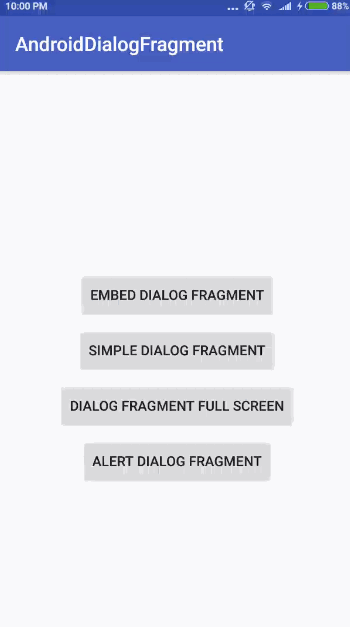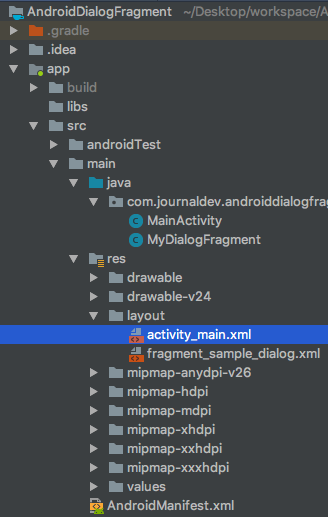在本教程中,我们将讨论什么是DialogFragments。我们将通过一个简单的安卓应用程序来了解它们与Dialogs的不同之处。
Androad# Dialogments
DialogFragment是扩展Fragment类的实用程序类。它是v4支持库的一部分,用于在位于其余内容顶部的活动中显示覆盖模式窗口。本质上,DialogFragment显示一个对话框,但在片段内。
Google建议我们在活动中使用DialogFragment,而不是简单的Alert Dialog生成器。
为什么会这样?
- DialogFragments有自己的生命周期方法。因此,该活动没有告诉对话框要做什么的责任。
- 不再有 IlLegalStateExceptions** 和泄漏的窗口崩溃。当活动在警报对话框仍在的情况下被销毁时,这种情况非常常见。
因为DialogFragment是一个片段,所以它集成到活动的生命周期中,并确保对话框窗口中发生的事情保持一致。在Android应用程序中使用DialogFragments创建对话框是一种很好的做法。您的类必须扩展DialogFragment,并至少实现onCreateDialog和/或onCreateView。可以通过两种方式使用DialogFragment创建对话框:
onCreateDialog-在这里可以使用AlertDialog.Builder类创建AlertDialog。onCreateView-在这里您可以使用定义的自定义视图创建一个Dialog。
为了创建显示对话框的DialogFragment,我们需要在DialogFragment实例上调用方法show(),如下所示:
1MyDialogFragment dialogFragment = new MyDialogFragment();
2FragmentTranscation ft = getSupportFragmentManager().beginTransaction();
3Fragment prev = getSupportFragmentManager().findFragmentByTag("dialog");
4if (prev != null) {
5 ft.remove(prev);
6}
7ft.addToBackStack(null);
8dialogFragment.show(ft, "dialog");
我们可以将任何标签设置为show()的第二个参数。为了创建将对话框嵌入到片段中的DialogFragment,我们只需像处理任何Fragment.一样将片段添加到Framelayout中
你知道吗您也可以在Fragments中显示自定义视图,而不仅仅是Dialog。
实例化DialogFragment类时。方法按以下顺序调用:
- onCreate
- online对话框
- onCreateView
- onViewCreated
- onDestroy
往返于DialogFragment的数据
为了将数据传递给DialogFragment类,我们只需在类的实例上使用setArguments设置数据即可。为了将来自DialogFragments的数据返回到Activity/另一个片段,我们需要创建自定义接口。在下一节中,我们将创建一个Android应用程序,该应用程序执行以下操作:
- 创建简单的DialogFragment对话框
- 活动中嵌入的对话框片段
- 有风格的DialogFragment。
- 返回数据的DialogFragment
项目结构
代码
activity_main.xml类的代码如下所示:
1<?xml version="1.0" encoding="utf-8"?>
2<RelativeLayout xmlns:android="https://schemas.android.com/apk/res/android"
3 xmlns:tools="https://schemas.android.com/tools"
4 android:layout_width="match_parent"
5 android:layout_height="match_parent"
6 android:orientation="vertical"
7 tools:context=".MainActivity">
8
9 <FrameLayout
10 android:id="@+id/frameLayout"
11 android:layout_width="match_parent"
12 android:layout_height="wrap_content"
13 android:layout_above="@+id/btnEmbedDialogFragment"
14 android:layout_alignParentTop="true" />
15
16 <Button
17 android:id="@+id/btnEmbedDialogFragment"
18 android:layout_width="wrap_content"
19 android:layout_height="wrap_content"
20 android:layout_centerHorizontal="true"
21 android:layout_above="@+id/btnDialogFragment"
22 android:text="EMBED DIALOG FRAGMENT" />
23
24 <Button
25 android:id="@+id/btnDialogFragment"
26 android:layout_width="wrap_content"
27 android:layout_height="wrap_content"
28 android:layout_centerInParent="true"
29 android:layout_marginTop="8dp"
30 android:text="SIMPLE DIALOG FRAGMENT" />
31
32 <Button
33 android:id="@+id/btnDialogFragmentFullScreen"
34 android:layout_width="wrap_content"
35 android:layout_height="wrap_content"
36 android:layout_below="@+id/btnDialogFragment"
37 android:layout_centerHorizontal="true"
38 android:layout_marginTop="8dp"
39 android:text="DIALOG FRAGMENT FULL SCREEN" />
40
41 <Button
42 android:id="@+id/btnAlertDialogFragment"
43 android:layout_width="wrap_content"
44 android:layout_height="wrap_content"
45 android:layout_below="@+id/btnDialogFragmentFullScreen"
46 android:layout_centerHorizontal="true"
47 android:layout_marginTop="8dp"
48 android:text="Alert Dialog Fragment" />
49
50 <TextView
51 android:id="@+id/textView"
52 android:layout_width="wrap_content"
53 android:layout_height="wrap_content"
54 android:layout_below="@+id/btnAlertDialogFragment"
55 android:layout_centerHorizontal="true" />
56
57</RelativeLayout>
每个按钮都会启动不同类型的DialogFragment。DialogFragment的自定义视图的XML布局在Fragment_Sample_Dialog.xml文件中定义,如下所示:
1<?xml version="1.0" encoding="utf-8"?>
2<LinearLayout xmlns:android="https://schemas.android.com/apk/res/android"
3 android:layout_width="match_parent"
4 android:layout_height="match_parent"
5 android:orientation="vertical"
6 android:padding="10dp">
7
8 <TextView
9 android:id="@+id/title"
10 android:layout_width="wrap_content"
11 android:layout_height="wrap_content"
12 android:layout_margin="16dp"
13 android:text="Please enter your username and password" />
14
15 <EditText
16 android:id="@+id/inEmail"
17 android:layout_width="match_parent"
18 android:layout_height="wrap_content"
19 android:hint="Email Address"
20 android:inputType="textEmailAddress" />
21
22 <EditText
23 android:id="@+id/inPassword"
24 android:layout_width="match_parent"
25 android:layout_height="wrap_content"
26 android:hint="Password"
27 android:inputType="textPassword" />
28
29 <Button
30 android:id="@+id/btnDone"
31 android:layout_width="match_parent"
32 android:layout_height="wrap_content"
33 android:text="Done" />
34</LinearLayout>
因此,我们的对话框将显示一个基本的登录表单。MainActivity.java的代码如下所示:
1package com.journaldev.androiddialogfragment;
2
3import android.support.v4.app.Fragment;
4import android.support.v4.app.FragmentTransaction;
5import android.support.v7.app.AppCompatActivity;
6import android.os.Bundle;
7import android.text.TextUtils;
8import android.view.View;
9import android.widget.Button;
10import android.widget.TextView;
11
12public class MainActivity extends AppCompatActivity implements View.OnClickListener, MyDialogFragment.DialogListener {
13
14 Button btnEmbedDialogFragment, btnDialogFragment, btnDialogFragmentFullScreen, btnAlertDialogFragment;
15 TextView textView;
16
17 @Override
18 protected void onCreate(Bundle savedInstanceState) {
19 super.onCreate(savedInstanceState);
20 setContentView(R.layout.activity_main);
21
22 textView = findViewById(R.id.textView);
23 btnEmbedDialogFragment = findViewById(R.id.btnEmbedDialogFragment);
24 btnDialogFragment = findViewById(R.id.btnDialogFragment);
25 btnDialogFragmentFullScreen = findViewById(R.id.btnDialogFragmentFullScreen);
26 btnAlertDialogFragment = findViewById(R.id.btnAlertDialogFragment);
27
28 btnEmbedDialogFragment.setOnClickListener(this);
29 btnDialogFragment.setOnClickListener(this);
30 btnDialogFragmentFullScreen.setOnClickListener(this);
31 btnAlertDialogFragment.setOnClickListener(this);
32
33 }
34
35 @Override
36 public void onClick(View view) {
37
38 switch (view.getId()) {
39 case R.id.btnEmbedDialogFragment:
40 MyDialogFragment dialogFragment = new MyDialogFragment();
41
42 FragmentTransaction ft = getSupportFragmentManager().beginTransaction();
43
44 ft.replace(R.id.frameLayout, dialogFragment);
45 ft.commit();
46 break;
47
48 case R.id.btnDialogFragment:
49 dialogFragment = new MyDialogFragment();
50
51 Bundle bundle = new Bundle();
52 bundle.putBoolean("notAlertDialog", true);
53
54 dialogFragment.setArguments(bundle);
55
56 ft = getSupportFragmentManager().beginTransaction();
57 Fragment prev = getSupportFragmentManager().findFragmentByTag("dialog");
58 if (prev != null) {
59 ft.remove(prev);
60 }
61 ft.addToBackStack(null);
62
63 dialogFragment.show(ft, "dialog");
64 break;
65
66 case R.id.btnDialogFragmentFullScreen:
67 dialogFragment = new MyDialogFragment();
68
69 bundle = new Bundle();
70 bundle.putString("email", "[email protected]");
71 bundle.putBoolean("fullScreen", true);
72 bundle.putBoolean("notAlertDialog", true);
73
74 dialogFragment.setArguments(bundle);
75
76 ft = getSupportFragmentManager().beginTransaction();
77 prev = getSupportFragmentManager().findFragmentByTag("dialog");
78 if (prev != null) {
79 ft.remove(prev);
80 }
81 ft.addToBackStack(null);
82
83 dialogFragment.show(ft, "dialog");
84 break;
85
86 case R.id.btnAlertDialogFragment:
87 dialogFragment = new MyDialogFragment();
88
89 ft = getSupportFragmentManager().beginTransaction();
90 prev = getSupportFragmentManager().findFragmentByTag("dialog");
91 if (prev != null) {
92 ft.remove(prev);
93 }
94 ft.addToBackStack(null);
95
96 dialogFragment.show(ft, "dialog");
97 break;
98 }
99 }
100
101 @Override
102 public void onFinishEditDialog(String inputText) {
103
104 if (TextUtils.isEmpty(inputText)) {
105 textView.setText("Email was not entered");
106 } else
107 textView.setText("Email entered: " + inputText);
108 }
109}
上面的类实现了一个接口MyDialogFragment. DialogFragment,每当DialogFragment的按钮被单击时,它就会触发方法onDialogshEditDialog。它显示在活动对话框中输入的数据。下面给出了MyDialogFragment.java类的代码:
1package com.journaldev.androiddialogfragment;
2
3import android.app.Dialog;
4import android.content.DialogInterface;
5import android.os.Bundle;
6import android.support.annotation.NonNull;
7import android.support.annotation.Nullable;
8import android.support.v4.app.DialogFragment;
9import android.support.v7.app.AlertDialog;
10import android.text.TextUtils;
11import android.util.Log;
12import android.view.LayoutInflater;
13import android.view.View;
14import android.view.ViewGroup;
15import android.widget.Button;
16import android.widget.EditText;
17
18public class MyDialogFragment extends DialogFragment {
19
20 @NonNull
21 @Override
22 public Dialog onCreateDialog(@Nullable Bundle savedInstanceState) {
23
24 if (getArguments() != null) {
25 if (getArguments().getBoolean("notAlertDialog")) {
26 return super.onCreateDialog(savedInstanceState);
27 }
28 }
29 AlertDialog.Builder builder = new AlertDialog.Builder(getActivity());
30 builder.setTitle("Alert Dialog");
31 builder.setMessage("Alert Dialog inside DialogFragment");
32
33 builder.setPositiveButton("Ok", new DialogInterface.OnClickListener() {
34 @Override
35 public void onClick(DialogInterface dialog, int which) {
36 dismiss();
37 }
38 });
39
40 builder.setNegativeButton("Cancel", new DialogInterface.OnClickListener() {
41 @Override
42 public void onClick(DialogInterface dialog, int which) {
43 dismiss();
44 }
45 });
46
47 return builder.create();
48
49 }
50
51 @Nullable
52 @Override
53 public View onCreateView(@NonNull LayoutInflater inflater, @Nullable ViewGroup container, @Nullable Bundle savedInstanceState) {
54 return inflater.inflate(R.layout.fragment_sample_dialog, container, false);
55
56 }
57
58 @Override
59 public void onViewCreated(@NonNull View view, @Nullable Bundle savedInstanceState) {
60 super.onViewCreated(view, savedInstanceState);
61
62 final EditText editText = view.findViewById(R.id.inEmail);
63
64 if (getArguments() != null && !TextUtils.isEmpty(getArguments().getString("email")))
65 editText.setText(getArguments().getString("email"));
66
67 Button btnDone = view.findViewById(R.id.btnDone);
68 btnDone.setOnClickListener(new View.OnClickListener() {
69 @Override
70 public void onClick(View view) {
71
72 DialogListener dialogListener = (DialogListener) getActivity();
73 dialogListener.onFinishEditDialog(editText.getText().toString());
74 dismiss();
75 }
76 });
77 }
78
79 @Override
80 public void onResume() {
81 super.onResume();
82
83 }
84
85 @Override
86 public void onCreate(@Nullable Bundle savedInstanceState) {
87 super.onCreate(savedInstanceState);
88
89 Log.d("API123", "onCreate");
90
91 boolean setFullScreen = false;
92 if (getArguments() != null) {
93 setFullScreen = getArguments().getBoolean("fullScreen");
94 }
95
96 if (setFullScreen)
97 setStyle(DialogFragment.STYLE_NORMAL, android.R.style.Theme_Black_NoTitleBar_Fullscreen);
98 }
99
100 @Override
101 public void onDestroyView() {
102 super.onDestroyView();
103 }
104
105 public interface DialogListener {
106 void onFinishEditDialog(String inputText);
107 }
108
109}
在onsightDialog中,我们创建一个普通的AlertDialog。dismiss()函数关闭对话框。下面给出了上述应用程序的输出: 请注意,在全屏对话框中,输入字段的数据已经传递。本教程到此结束。您可以从下面的链接下载该项目:
请注意,在全屏对话框中,输入字段的数据已经传递。本教程到此结束。您可以从下面的链接下载该项目:
